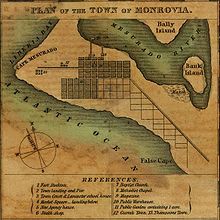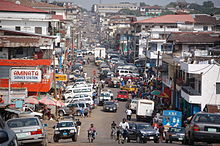
Monrovia
Did you know...
SOS Children, which runs nearly 200 sos schools in the developing world, organised this selection. Do you want to know about sponsoring? See www.sponsorachild.org.uk
| Monrovia | |
|---|---|
| — City — | |
| City of Monrovia | |
| Broad Street, Monrovia, Liberia. The Old Ducor Hotel is visible in the background. | |
|
|
|
| Coordinates: 6°18′48″N 10°48′5″W Coordinates: 6°18′48″N 10°48′5″W | |
| Country | |
| County | Montserrado |
| District | Greater Monrovia |
| Established | April 25, 1822 |
| Named for | James Monroe -U.S. President |
| Government | |
| • Mayor | Mary Broh |
| Population (2008) | |
| • Metro | 970,824 |
| Time zone | GMT ( UTC+0) |
Monrovia is the capital city of the West African nation of Liberia. Located on the Atlantic Coast at Cape Mesurado, it lies geographically within Montserrado County, but is administered separately. The city is governed as a metropolitan city called Greater Monrovia District, which had a population of 970,824 as of the 2008 census, containing 29% of the total population of Liberia and is the country's most populous city. Monrovia is the cultural, political and financial hub for the entire country. The body that administers the government of Greater Monrovia District is the Monrovia City Corporation.
Founded in 1822, Monrovia is named in honour of U.S. President James Monroe, a prominent supporter of the colonization of Liberia. Along with Washington, D.C., it is one of two national capitals to be named after a U.S. President. Monrovia was founded thirty years after Freetown, Sierra Leone, the first permanent Black American settlement in Africa. The city's economy is dominated by its harbor, and government offices. Monrovia's harbour was significantly expanded by U.S. forces during the Second World War and the main exports include latex and iron ore. Materials are also manufactured on-site, such as cement, refined petroleum, food products, bricks and tiles, furniture and chemicals. Located near the confluence of the Mesurado and Saint Paul rivers, the harbour also has facilities for storing and repairing vessels.
History
The area was already inhabited when it was named Cape Mesurado by Portuguese sailors in the 1560s.
In 1821, with the aim of establishing a self-sufficient colony for emancipated American survivors of slavery, something that had already been accomplished in Freetown, the first settlers arrived in Africa from the United States, under the auspices of the American Colonization Society. They landed at Sherbro Island in present-day Sierra Leone. The undertaking was a shambles and many settlers died. In 1822, a second ship rescued the settlers and took them to Cape Mesurado, establishing the settlement of Christopolis. In 1824, the city was renamed to Monrovia after James Monroe, then President of the United States, and a prominent supporter of the colony in sending freed Black slaves to Liberia, saw it as preferable than emancipation in America.
In 1845, Monrovia was the site of the constitutional convention held by the American Colonization Society which drafted the constitution that would two years later be the constitution of an independent and sovereign Republic of Liberia.
At the beginning of the 20th century, Monrovia was divided into two parts: (1) Monrovia proper, where the city's Americo-Liberian population resided and was reminiscent of the Southern United States in architecture; and (2) Krutown, which was mainly inhabited by ethnic Krus but also Bassas, Grebos and other tribes. Of the 4,000 residents, 2,500 were Americo-Liberian. By 1926, ethnic groups from Liberia's interior began migrating to Monrovia in search of jobs.
In 1979, the Organisation of African Unity held their conference in the Monrovia area, with then president William R. Tolbert as chairman. During his term, Tolbert improved public housing in Monrovia and decreased by 50% the tuition fees at the University of Liberia. A military coup led by Samuel Doe ousted the Tolbert government in 1980, with many members being executed.
The city was severely damaged in the First and Second Liberian Civil Wars, notably during the siege of Monrovia, with many buildings damaged and nearly all the infrastructure destroyed. Major battles occurred between Samuel Doe's government and Prince Johnson's forces in 1990 and with the NPFL's assault on the city in 1992. A legacy of the war is a large population of homeless children and youths, either having been involved in the fighting or denied an education by it.
In 2002, Leymah Gbowee organized the Women of Liberia Mass Action for Peace with local women praying and singing in a fish market in Monrovia. This movement helped bring an end to the Second Liberian Civil War in 2003 and the election of Ellen Johnson Sirleaf in Liberia, the first African nation with a female president.
Economy
The city's economy is dominated by its harbour, the Freeport of Monrovia. Monrovia is Liberia's financial centre. The Central Bank of Liberia is based in Monrovia.
Government
The city is home to the Monrovia City Corporation, which runs many services inside the city.
Former mayors include:
- W. F. Nelson, 1870s
- C. T. O. King, 1880s and served three terms
- H. A. Williams, 1890s
- Gabriel M. Johnson, 1920s
- Nathan C. Ross, 1956-1969
- Ellen A. Sandimanie, 1970s and first woman to hold the position
- Ophelia Hoff Saytumah, 2001–2009
Geography
Monrovia lies along the Cape Mesurado peninsula, between the Atlantic Ocean and the Mesurado River, whose mouth forms a large natural harbour. The Saint Paul River lies directly north of the city and forms the northern boundary of Bushrod Island, which is reached by crossing the "New Bridge" from downtown Monrovia. Monrovia is located at 6°19′N 10°48′W. Monrovia is Liberia's largest city and its administrative, commercial and financial centre. Geographically, Monrovia is the African city closest to South America, 1882.2 miles (3029.2 kilometers, or 1634.5 nautical miles) across the Atlantic from Natal, Brazil.
The city is located in Montserrado County. However, the small town of Bensonville is actually the capital of Montserrado County.
Climate
Under the Köppen climate classification, Monrovia features a tropical monsoon climate. During the course of the year Monrovia sees a copious amount of precipitation. Monrovia averages 5,300 mm (208.7 in) of rain per year. The climate features a wet season and a dry season, but precipitation is seen even during the dry season. Temperatures remain constant throughout the year averaging around 26 degrees Celsius (79 degrees Fahrenheit).
| Climate data for Monrovia | |||||||||||||
|---|---|---|---|---|---|---|---|---|---|---|---|---|---|
| Month | Jan | Feb | Mar | Apr | May | Jun | Jul | Aug | Sep | Oct | Nov | Dec | Year |
| Record high °C (°F) | 32 (90) |
33 (91) |
32 (90) |
33 (91) |
34 (93) |
31 (88) |
29 (84) |
30 (86) |
29 (84) |
30 (86) |
32 (90) |
32 (90) |
34 (93) |
| Average high °C (°F) | 30 (86) |
29 (84) |
31 (88) |
31 (88) |
30 (86) |
27 (81) |
27 (81) |
27 (81) |
27 (81) |
28 (82) |
29 (84) |
30 (86) |
29 (84) |
| Average low °C (°F) | 23 (73) |
23 (73) |
23 (73) |
23 (73) |
22 (72) |
23 (73) |
22 (72) |
23 (73) |
22 (72) |
22 (72) |
23 (73) |
23 (73) |
23 (73) |
| Record low °C (°F) | 18 (64) |
20 (68) |
19 (66) |
16 (61) |
16 (61) |
18 (64) |
16 (61) |
18 (64) |
18 (64) |
19 (66) |
17 (63) |
17 (63) |
16 (61) |
| Precipitation mm (inches) | 31 (1.22) |
56 (2.2) |
97 (3.82) |
216 (8.5) |
516 (20.31) |
973 (38.31) |
1,150 (45.28) |
373 (14.69) |
744 (29.29) |
778 (30.63) |
236 (9.29) |
130 (5.12) |
5,300 (208.66) |
| Source: BBC Weather | |||||||||||||
Education
Monrovia is home to the University of Liberia, along with African Methodist Episcopal University, Stella Maris Polytechnic, and many other public and private schools. Medical education is offered at the A.M. Dogliotti College of Medicine, and there is a nursing and paramedical school at the Tubman National Institute of Medical Arts.
Kindergarten through twelfth grade education is provided by the Monrovia Consolidated School System, which serves the Greater Monrovia area. Schools include Monrovia Central High School, Bostwain High School, D. Twe High School, G. W. Gibson High School and William V. S. Tubman High School.
Infrastructure
Boats link the city's Freeport of Monrovia, the country's busiest port, with Greenville and Harper. The nearest airport is Spriggs Payne Airport, located less than four miles from the city centre. Roberts International Airport, the largest international airport in Liberia, is 60 km (40 mi) away in Harbel. The city is connected with the rest of the country via a network of roads and railways. Monrovia is listed as the home port by between ten and fifteen percent of the world's merchant shipping, registered in Liberia under Flag of Convenience arrangements. Both private taxis and minibuses run in the city, and are supplemented by larger buses run by the Monrovia Transit Authority. Prior to the wars, the Mount Coffee Hydropower Project provided electricity and drinking water to the city. In recent years (2005–present)the roads on many streets in Monrovia have been rebuilt by World Bank and the Liberian Government; private and public infrastructures are being built or renovated as reconstruction takes place.
Neighborhoods
The city of Monrovia consists of several districts, spread across the Mesurado peninsula, with the greater Metropolitan area encircling the marshy Mesurado river's mouth. The historic downtown, centered around Broad Street, is at the very end of the peninsula, with the major market district, Waterside, immediately to the north, facing the city's large natural harbour. Northwest of Waterside is the large, low-income West Point community. To the west/southwest of downtown lies Mamba Point, traditionally the city's principal diplomatic quarter, and home to the Embassies of the United States and United Kingdom as well as the European Union Delegation. South of the city centre is Capitol Hill, where the major institutions of national government, including the Temple of Justice and the Executive Mansion, are located. Further east down the peninsula is the Sinkor section of Monrovia. Originally a suburban residential district, today Sinkor acts as Monrovia's bustling mid-town, hosting many diplomatic missions, as well as major hotels, businesses, as well as several residential neighborhoods, including informal communities such as Plumkor, Jorkpentown, Lakpazee and Fiamah. Sinkor is also home to the city's secondary airport, Spriggs Payne, and the area immediately nearby, called Airfield, is a major nightlife district for the whole city. Further east of the Airfield is the Old Road section of Sinkor, which is predominantly residential, including informal settlements like Chugbor and Gaye Town. At the southeasterly base of the peninsula is the independent township of Congo Town, and to its east is the large suburb of Paynesville. Other suburbs such as Chocolate City, Gardnersville, Barnersville, Kaba Town, Dandawailo, and New Georgia lie to the north, across the river. To the east of the neighborhoods of New Kru Town and Logan Town, are the far eastern suburbs of Stockton Creek Bridge, Caldwell, Louisiana and Cassava Hill.
- Other neighborhoods and suburbs of Monrovia include
|
|
|
|






